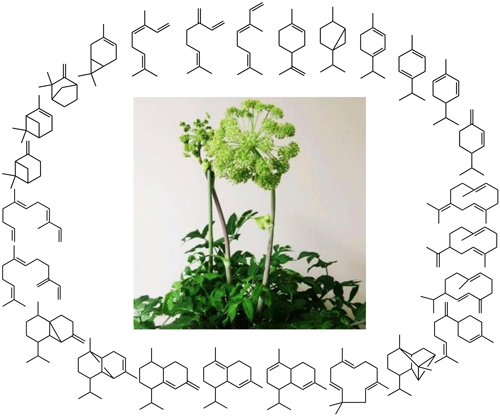- 著者
- Miki Suenaga-Hiromori Daisuke Mogi Yohei Kikuchi Jiali Tong Naotsugu Kurisu Yuichi Aoki Hiroyuki Amano Masahiro Furutani Takefumi Shimoyama Toshiyuki Waki Toru Nakayama Seiji Takahashi
- 出版者
- Japanese Society for Plant Biotechnology
- 雑誌
- Plant Biotechnology (ISSN:13424580)
- 巻号頁・発行日
- vol.39, no.4, pp.391-404, 2022-12-25 (Released:2022-12-25)
- 参考文献数
- 33
- 被引用文献数
- 1
Angelica archangelica L. is a traditional medicinal plant of Nordic origin that produces an unusual amount and variety of terpenoids. The unique terpenoid composition of A. archangelica likely arises from the involvement of terpene synthases (TPSs) with different specificities, none of which has been identified. As the first step in identifying TPSs responsible for terpenoid chemodiversity in A. archangelica, we produced a transcriptome catalogue using the mRNAs extracted from the leaves, tap roots, and dry seeds of the plant; 11 putative TPS genes were identified (AaTPS1–AaTPS11). Phylogenetic analysis predicted that AaTPS1–AaTPS5, AaTPS6–AaTPS10, and AaTPS11 belong to the monoterpene synthase (monoTPS), sesquiterpene synthase (sesquiTPS), and diterpene synthase clusters, respectively. We then performed in vivo enzyme assays of the AaTPSs using recombinant Escherichia coli systems to examine their enzymatic activities and specificities. Nine recombinant enzymes (AaTPS2–AaTPS10) displayed TPS activities with specificities consistent with their phylogenetics; however, AaTPS5 exhibited a strong sesquiTPS activity along with a weak monoTPS activity. We also analyzed terpenoid volatiles in the flowers, immature and mature seeds, leaves, and tap roots of A. archangelica using gas chromatography-mass spectrometry; 14 monoterpenoids and 13 sesquiterpenoids were identified. The mature seeds accumulated the highest levels of monoterpenoids, with β-phellandrene being the most prominent. α-Pinene and β-myrcene were abundant in all organs examined. The in vivo assay results suggest that the AaTPSs functionally identified in this study are at least partly involved in the chemodiversity of terpenoid volatiles in A. archangelica.
- 著者
- Hideki Okata Waku Hatta Katsunori Iijima Kiyotaka Asanuma Atsuki Tsuruya Naoki Asano Tomoyuki Koike Shin Hamada Toru Nakayama Atsushi Masamune Tooru Shimosegawa
- 出版者
- Tohoku University Medical Press
- 雑誌
- The Tohoku Journal of Experimental Medicine (ISSN:00408727)
- 巻号頁・発行日
- vol.244, no.4, pp.317-325, 2018 (Released:2018-04-20)
- 参考文献数
- 31
- 被引用文献数
- 4
Ethanol is oxidized by alcohol dehydrogenase to acetaldehyde, a recognized carcinogen for the esophagus. However, no previous study has measured the acetaldehyde levels in the esophageal tissue. L-cysteine has been shown to reduce the acetaldehyde levels in the saliva; however, it is unknown whether L-cysteine intake affects the acetaldehyde concentration in the esophageal tissue. The aim of this study was to measure the acetaldehyde concentration in the esophageal tissue after ethanol drinking and evaluate the effect of L-cysteine intake on the acetaldehyde levels in the esophagus. We enrolled 10 male subjects with active acetaldehyde dehydrogenase-2*1/*1 (ALDH2*1/*1) genotype and 10 male subjects with the inactive acetaldehyde dehydrogenase-2*1/*2 (ALDH2*1/*2) genotype, the mean ages of whom were 25.6 and 27.9 years, respectively. In this prospective, single-blind, placebo-controlled study using L-cysteine and placebo lozenges (first and second examination), saliva and blood were collected before and after ethanol drinking. Esophageal tissue was obtained by endoscopic biopsy at 60 minutes after drinking, and the acetaldehyde and ethanol concentrations were measured. The acetaldehyde concentration of the saliva was significantly lower in those taking L-cysteine than in those taking the placebo. Acetaldehyde in the esophageal tissue was detected only in those taking L-cysteine lozenges. There were no correlations between the acetaldehyde concentrations in the esophageal tissue and saliva or blood. In conclusion, we detected acetaldehyde in the human esophageal tissue after ethanol drinking. Unexpectedly, intake of L-cysteine lozenges appears to contribute to detection of acetaldehyde in the esophageal tissue.
